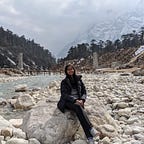Gangtok Diary 1.0
“Vah raat mei jagmagaata Gangtok sahar tha… itihaas or vartmaan ke sandhi-sthal par khada mehnatkash baadsahon ka wo ek aisa sahar tha jiska sabkuch sundar tha - subah, shaam, raat.” — Madhu Kankaria
It’s been two months since I first stepped out of the taxi on a chilly night in Gangtok. My journey from Bagdogra airport till Gangtok was a mix of the joy of finally going out after ten months of homestay due to the pandemic and a tinge of regret of having chosen a hilly area for my six months long architectural internship. Why you ask? Because I hail from a town called Haldwani in Nainital, and I never got used to curvy mountain roads, all hair-pin bend signboards are more of you’re-going-to throw-up warnings to me, and I didn’t have a good feeling about being travel sick in the coming months. However, the very first week in this place changed everything, there’s so much that I can write about the people (my co-interns from different parts of India) I met here and had/stilling having the fun of a lifetime with, but that should be kept for another day. So today, let’s talk about this place with roadside wall slogans like “Nature never goes out of style.”, for this place holds so much beauty that you’ll find yourself incapable of taking it all in.
Did you know that Sikkim was not a part of India until 1975? If your historical knowledge is as poor as mine, you probably didn’t know that, and if you visit Sikkim, the accepting nature of this place will not even let you believe that it was not a part of independent India until so late. It’s sad that other Indian states could never reciprocate this kind of acceptance towards the Sikkimese and they still find themselves to be in limbo, stuck between past exclusion and present belongingness to India. Sikkimese are often teased as Nepali, Korean, Chinese and what not whenever they step out into other parts of the country. Initially, even I felt fascinated that the people here look sort of Japanese, that their regional dress looks like Kimono (traditional Japanese garment) and that their local dish Thukpa looks like Ramen, I was just a toxic anime fan trying to find parallels. But after interacting with the local people I realised how alienating such thoughts were for the natives of this place, people who are being wholeheartedly welcoming to outsiders and yet being denied the perception of being a fellow Indian.
Sikkim is beautiful through and through, not just in indescribable heavenly sceneries which are like sparkled pieces of paradise, but also in its people and culture. Everyone, right from shop wali didis to taxi wale bhaiyas, would talk and joke like you’ve been friends with them for a long time. At a food outlet where we usually eat, the shop owner would help the workers serve and clean even if she has visited for just five minutes, seems like social class differences slipped off some high cliff and died. At another shop, the bhaiya would serve you second (even third or fourth) helping of food more forcefully than your mother. Every time you cross path with locals, a hushed smile on their faces would be asking you “Did you witness the beauty of my land?” There’s some kind of purity in the way this place has nurtured mankind, the way it has taught the lesson of co-existence to all living beings. There’s negligible pollution because people pray and bow to nature’s bounty, I didn’t see a single plastic bag in my past two months of stay here. Even if you buy a Glucon-D pack, the shopkeeper will pack it in newspaper and hand it over with both the hands like a respectful gift.
One thing that you can’t miss about the people of capital city Gangtok is their fitness, maintained appearance and dress-up sense. Crossing MG Marg, Gangtok’s upbeat market, you’d wonder whether half of the people are fashion icons and if it is a European street flanked by lively shops, restaurants and cafes on both the sides and Victorian street lamps, benches, landscaped flowers and trees through the middle. A native architect from my office expressed, “Outsiders label our dressing-up as vanity, but I think it’s about always presenting your best self.” She told that her maid used to come in hot pants and a hat and would be scrubbing and mopping the floor all dressed up like that. It’s funny as well as a fascinating scene to picture, interesting that these people have learnt to respect and care for their body and to live out beautifully. I would say there’s a humbleness that floats in the eyes of every Sikkimese and a modest pride in the way they present themselves.
Can anyone ever have enough words to romanticize the natural beauty of this place? Mornings with Kangchenjunga peak in distance reflecting sunlight with utmost ferocity, country roads leading to homes of sweetest people out there, snow-laden mountains that appear to have showered with pixie dust, streams making their way around the spreads of rocks just to turn into magnificent waterfalls, lakes delicately wearing a thin fabric of snow, colourful prayer flags waving incessantly atop mountains declaring the rule of love and compassion, journeys soaked in newness and an entire human civilization balancing itself on these steep-sloped mountains. Are there any poets poetic enough to pen it all down? I hope there are. So that someday later in my life, mere words would touch-up these memories which might have faded a little by then. I hope there’s a storyteller skilled enough to bring me back to today evening with rain pouring outside my room window, a warm blanket, a joy-filled heart and a few words of reverence for this place rolling down my pen.
